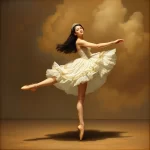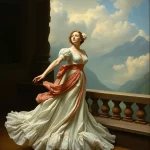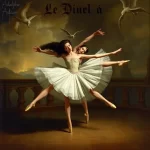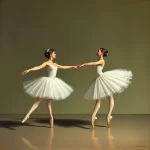Ballet: La Fille du Pharaon (Cesare Pugni, 1862)

Introduction
La Fille du Pharaon (The Pharaoh’s Daughter) is a grand ballet in three acts, choreographed by Marius Petipa and composed by Cesare Pugni. Premiering on January 18, 1862, at the Imperial Bolshoi Kamenny Theatre in St. Petersburg, Russia, this ballet is a quintessential example of the lavish productions of the Imperial Russian Ballet. The ballet’s plot revolves around an Englishman named Lord Wilson who, during a trip to Egypt, dreams of an ancient Egyptian princess, Aspicia, and embarks on a fantastical adventure filled with romance, danger, and magic.
Historical Background
Creation and Development
The mid-19th century was a period of significant cultural and artistic development in Russia, with the Imperial Russian Ballet at the forefront of this transformation. The creation of La Fille du Pharaon was influenced by the era’s fascination with exotic locales and historical themes. The ballet was inspired by Théophile Gautier’s novel Le Roman de la Momie, which provided a rich narrative backdrop for the ballet’s fantastical elements.
Marius Petipa, the choreographer, collaborated closely with composer Cesare Pugni to bring this vision to life. Petipa’s innovative choreography and Pugni’s evocative score combined to create a ballet that was both visually and musically stunning. The production also involved elaborate set designs and costumes, reflecting the grandeur and opulence of ancient Egypt.
Premiere and Reception
La Fille du Pharaon premiered on January 18, 1862, at the Imperial Bolshoi Kamenny Theatre in St. Petersburg. The initial reception was overwhelmingly positive, with critics and audiences alike praising the ballet’s spectacular staging, intricate choreography, and Pugni’s memorable score. The ballet quickly became a staple of the Imperial Russian Ballet’s repertoire, with numerous revivals and performances throughout the late 19th and early 20th centuries.
Synopsis of the Ballet
Act I Summary
The ballet opens with Lord Wilson and his servant, John Bull, traveling through Egypt. They seek refuge in a pyramid during a sandstorm and encounter a mysterious old man who offers them opium. As Lord Wilson falls asleep, he dreams of the ancient Egyptian princess Aspicia. In his dream, he is transformed into Ta-Hor, an Egyptian nobleman. Aspicia, the Pharaoh’s daughter, is betrothed to the King of Nubia but falls in love with Ta-Hor. The act ends with Aspicia and Ta-Hor planning to escape together.
Act II Summary
In Act II, Aspicia and Ta-Hor flee through the Egyptian countryside, pursued by the Pharaoh’s guards. They encounter various obstacles, including a dangerous river crossing and an encounter with a lion. Aspicia bravely saves Ta-Hor from the lion, showcasing her courage and determination. The act culminates in a dramatic confrontation between the lovers and the Pharaoh’s forces, with Aspicia and Ta-Hor narrowly escaping capture.
Act III Summary
Act III sees Aspicia and Ta-Hor seeking refuge in a temple dedicated to the goddess Isis. The high priestess offers them sanctuary, but their peace is short-lived as the Pharaoh’s guards close in. In a climactic battle, Ta-Hor is captured, and Aspicia is forced to return to the palace. However, the goddess Isis intervenes, granting Aspicia and Ta-Hor a miraculous escape. The ballet concludes with Lord Wilson awakening from his dream, forever changed by his fantastical adventure.
Finale
The finale of La Fille du Pharaon is a triumphant celebration of love and bravery. Aspicia and Ta-Hor’s love transcends time and space, symbolizing the enduring power of true love. The ballet’s conclusion leaves audiences with a sense of wonder and enchantment, as Lord Wilson reflects on his extraordinary dream.
Musical Composition
Composer’s Role
Cesare Pugni, an Italian composer, played a crucial role in the creation of La Fille du Pharaon. Known for his prolific output and ability to craft music that perfectly complemented the choreography, Pugni’s score for this ballet is a masterful blend of melodic richness and rhythmic vitality. His music enhances the narrative, providing an emotional depth that elevates the ballet’s dramatic moments.
Musical Themes and Motifs
Pugni’s score for La Fille du Pharaon features several recurring musical themes and motifs that underscore the ballet’s key moments. The use of leitmotifs helps to establish character identities and emotional states, creating a cohesive musical narrative. For example, Aspicia’s theme is characterized by a lyrical, flowing melody that reflects her grace and nobility, while Ta-Hor’s theme is more robust and heroic, highlighting his bravery and determination.
Famous Recordings and Performances
Over the years, there have been several notable recordings and performances of Pugni’s score for La Fille du Pharaon. One of the most iconic recordings is by the Bolshoi Theatre Orchestra, conducted by Alexander Sotnikov. This recording captures the grandeur and emotional depth of Pugni’s music, making it a favorite among ballet enthusiasts.
Choreography and Dance
Choreographer’s Vision
Marius Petipa’s choreography for La Fille du Pharaon is a testament to his innovative approach and artistic vision. Petipa’s choreography combines classical ballet techniques with elements of character dance, creating a rich and varied movement vocabulary. His use of intricate footwork, grand lifts, and expressive gestures helps to convey the ballet’s dramatic narrative and emotional nuances.
Signature Dance Numbers
One of the most memorable dance numbers in La Fille du Pharaon is the Pas de Deux between Aspicia and Ta-Hor. This duet showcases the technical prowess and emotional connection between the two lead dancers, with a series of breathtaking lifts and intricate partnering work. Another standout moment is Aspicia’s solo variation, which highlights her grace and strength through a series of challenging turns and jumps.
Notable Interpretations
Over the years, different productions of La Fille du Pharaon have offered unique interpretations of Petipa’s choreography. Some productions have emphasized the ballet’s exotic and fantastical elements, while others have focused on the emotional depth of the characters’ relationships. Notable interpretations include those by the Bolshoi Ballet and the Mariinsky Ballet, both of which have brought their own distinctive styles to the ballet.
Characters and Roles
Main Characters
- Aspicia: The Pharaoh’s daughter, a noble and courageous princess who falls in love with Ta-Hor.
- Ta-Hor: An Egyptian nobleman and the dream alter-ego of Lord Wilson, who becomes Aspicia’s lover.
- Lord Wilson: An Englishman who dreams of becoming Ta-Hor and embarking on a fantastical adventure in ancient Egypt.
Supporting Characters
- John Bull: Lord Wilson’s servant, who accompanies him on his journey.
- The Pharaoh: Aspicia’s father, who initially opposes her relationship with Ta-Hor.
- The King of Nubia: Aspicia’s betrothed, who becomes a rival to Ta-Hor.
Famous Dancers
Several renowned dancers have portrayed the lead roles in La Fille du Pharaon over the years. Notable performers include Mathilde Kschessinskaya, who was celebrated for her portrayal of Aspicia, and Pavel Gerdt, who brought depth and charisma to the role of Ta-Hor. In more recent times, dancers such as Svetlana Zakharova and Vladimir Malakhov have also received acclaim for their performances in this ballet.
Cultural and Artistic Impact
Influence on Ballet and Dance
La Fille du Pharaon has had a significant influence on the development of ballet as an art form. Its grand scale and elaborate production values set a new standard for ballet performances, inspiring other choreographers and composers to create similarly ambitious works. The ballet’s success also helped to solidify Marius Petipa’s reputation as one of the leading choreographers of his time.
Cultural Significance
The ballet’s exotic setting and fantastical elements have made it a popular subject in various forms of media. La Fille du Pharaon has been adapted into film, theater, and even literature, reflecting its enduring appeal. The ballet’s themes of love, adventure, and heroism continue to resonate with audiences, making it a timeless classic.
Legacy and Revivals
La Fille du Pharaon has seen numerous revivals and reinterpretations over the years. Major revivals by companies such as the Bolshoi Ballet and the Mariinsky Ballet have helped to keep the ballet alive for new generations of audiences. Modern adaptations have also brought fresh perspectives to the ballet, incorporating contemporary choreography and design elements while staying true to the original spirit of the work.
Iconic Productions
Historic Productions
One of the most famous historical productions of La Fille du Pharaon was the 1898 revival by the Imperial Russian Ballet, which featured Mathilde Kschessinskaya as Aspicia and Pavel Gerdt as Ta-Hor. This production was notable for its lavish sets and costumes, as well as its innovative use of stage machinery to create special effects.
Contemporary Productions
Recent productions of La Fille du Pharaon have continued to captivate audiences with their blend of traditional and modern elements. The Bolshoi Ballet’s 2000 revival, choreographed by Pierre Lacotte, is a prime example of how contemporary productions can breathe new life into classic works. Lacotte’s choreography retained the grandeur of Petipa’s original while incorporating modern techniques and sensibilities.
Production Design
The set, costume, and lighting design in various productions of La Fille du Pharaon have played a crucial role in bringing the ballet’s fantastical world to life. From the opulent palace interiors to the mystical temple of Isis, each production has sought to create a visually stunning experience for audiences. Notable designers such as Simon Virsaladze and Franca Squarciapino have contributed their talents to various productions, enhancing the ballet’s visual appeal.
Critical Reception and Reviews
Initial Critical Response
At the time of its premiere, La Fille du Pharaon received glowing reviews from critics. The ballet was praised for its innovative choreography, captivating music, and spectacular staging. Critics lauded Petipa’s ability to blend classical ballet techniques with character dance, creating a rich and varied movement vocabulary that brought the story to life.
Modern Reviews
Contemporary critics continue to appreciate La Fille du Pharaon for its historical significance and artistic merit. Modern reviews often highlight the ballet’s enduring appeal, noting how its themes of love and adventure remain relevant to today’s audiences. The ballet’s elaborate production values and intricate choreography are also frequently praised, with many critics considering it a masterpiece of the classical ballet repertoire.
Fun Facts and Trivia
Behind-the-Scenes Stories
One interesting anecdote from the original production of La Fille du Pharaon involves the use of live animals on stage. In one scene, a live lion was brought onto the stage to add to the realism of the ballet’s exotic setting. This daring choice added an element of excitement and danger to the performance, captivating audiences and critics alike.
Notable Performers
Over the years, many famous dancers have been associated with La Fille du Pharaon. Mathilde Kschessinskaya, one of the most celebrated ballerinas of her time, was known for her portrayal of Aspicia. In more recent times, dancers such as Svetlana Zakharova and Vladimir Malakhov have also received acclaim for their performances in this ballet.
Trivia
- Exotic Inspiration: The ballet was inspired by Théophile Gautier’s novel Le Roman de la Momie, which provided a rich narrative backdrop for the ballet’s fantastical elements.
- Live Animals: The original production featured live animals on stage, including a lion, adding to the realism and excitement of the performance.
- Innovative Choreography: Marius Petipa’s choreography for La Fille du Pharaon was groundbreaking for its time, blending classical ballet techniques with character dance.
Conclusion
Summary of the Ballet’s Importance
La Fille du Pharaon is a significant work in the world of ballet, showcasing the artistic vision of Marius Petipa and the musical genius of Cesare Pugni. Its grand scale, elaborate production values, and innovative choreography set a new standard for ballet performances, influencing generations of choreographers and composers.
Final Thoughts
La Fille du Pharaon remains a timeless classic, captivating audiences with its themes of love, adventure, and heroism. Its enduring appeal is a testament to the power of ballet to transport audiences to fantastical worlds and evoke deep emotions. Whether you are a seasoned ballet enthusiast or a newcomer to the art form, La Fille du Pharaon is a must-see performance that continues to inspire and enchant.
FAQ
What is the central theme of this ballet?
The central theme of La Fille du Pharaon is the enduring power of love, as exemplified by the romantic relationship between Aspicia and Ta-Hor.
Who are the main characters in this ballet?
The main characters are Aspicia (the Pharaoh’s daughter), Ta-Hor (an Egyptian nobleman), and Lord Wilson (an Englishman who dreams of becoming Ta-Hor).
What is the most famous dance number in this ballet?
The Pas de Deux between Aspicia and Ta-Hor is one of the most famous dance numbers in La Fille du Pharaon, showcasing the technical prowess and emotional connection between the lead dancers.
How long does a typical performance of this ballet last?
A typical performance of La Fille du Pharaon lasts approximately 2.5 to 3 hours, including intermissions.
Are there any modern adaptations of this ballet?
Yes, there have been several modern adaptations of La Fille du Pharaon, including notable revivals by the Bolshoi Ballet and the Mariinsky Ballet.
Why is this ballet considered important in the history of dance?
La Fille du Pharaon is considered important in the history of dance due to its innovative choreography, elaborate production values, and significant influence on the development of ballet as an art form.





